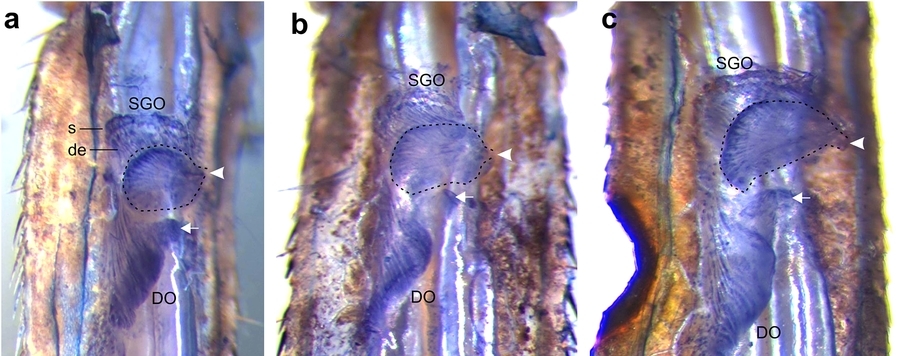
The Subgenual Organ Complex in Stick Insects
Leg chordotonal organs in insects show different adaptations to detect body movements, substrate vibrations, or airborne sound. In the proximal tibia of stick insects occur two chordotonal organs: the subgenual organ, a highly sensitive vibration receptor organ, and the distal organ, of which the function is yet unknown. The distal organ consists of a linear set of scolopidial sensilla extending in the tibia in distal direction toward the tarsus. Similar organs occur in the elaborate hearing organs in crickets and bushcrickets, where the auditory sensilla are closely associated with thin tympanal membranes and auditory trachea in the leg. Here, we document the position and attachment points for the distal organ in three species of stick insects without auditory adaptations (Ramulus artemis, Sipyloidea sipylus, and Carausius morosus). The distal organ is located in the dorsal hemolymph channel and attaches at the proximal end to the dorsal and posterior leg cuticle by tissue strands. The central part of the distal organ is placed closer to the dorsal cuticle and is suspended by fine tissue strands. The anterior part is clearly separated from the tracheae, while the distal part of the organ is placed over the anterior trachea. The distal organ is not connected to a tendon or muscle, which would indicate a proprioceptive function. The sensilla in the distal organ have dendrites oriented in distal direction in the leg. This morphology does not reveal obvious auditory adaptations as in tympanal organs, while the position in the hemolymph channel and the direction of dendrites indicate responses to forces in longitudinal direction of the leg, likely vibrational stimuli transmitted in the leg’s hemolymph. The evolutionary convergence of complex chordotonal organs with linear sensilla sets between tympanal hearing organs and atympanate organs in stick insects is emphasized by the different functional morphologies and sensory specializations.






